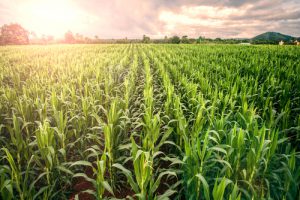
U.S. Reps. Kristi Noem (R-SD), Glenn ‘GT’ Thompson (R-PA), John Moolenaar (R-MI) and members of the U.S House Agriculture Committee on April 12 introduced a bipartisan draft of the 2018 Farm Bill proposing economic policy solutions for America’s farmers and ranchers and making some 35 improvements to the nation’s food stamps program.
The Agriculture and Nutrition Act of 2018, H.R. 2., is a “critical component” of the Republican agenda to “combine work requirements with work supports,” said U.S. House Speaker Paul Ryan during an April 12 press conference that preceded release of the draft proposal by U.S. Rep. Michael Conaway (R-TX), chairman of the U.S. House Agriculture Committee. Rep. Ryan (R-WI) said during his weekly address that he thinks the House can get the bill passed and he’d like to do so this spring.
The Farm Bill makes up roughly 2 percent of all federal funding, according to a statement from Rep. Thompson’s office, but 80 percent of total Farm Bill spending goes toward nutrition programs. The remainder supports farmers, ranchers and consumers through commodity programs, agricultural research, trade and rural development. The bill gets renewed every five years.
Among one of the most notable changes under H.R. 2 would be changes to existing work requirements for the Supplemental Nutrition Assistance Program (SNAP), commonly known as food stamps, received by about 5 million to 7 million low-income U.S. residents. Rep. Thompson, chairman of the U.S. House Agriculture Subcommittee on Nutrition, said since 2015 the subcommittee held 21 hearings on SNAP, heard more than 80 witnesses testify on program improvements, and worked “in earnest toward the goal of ending hunger in America.”
The result, according to a top-10 highlights page on the Farm Bill issued by the House Agriculture Committee, is that SNAP recipients under H.R. 2 could choose among streamlined work requirements paired with several options to get SNAP benefits, including to participate in a fully funded, guaranteed Employment & Training (E&T) slot. “Individuals may choose not to participate, but they will no longer be eligible for SNAP,” according to the committee summary.
“While the bill continues SNAP assistance to our most vulnerable, the legislation also provides new opportunities for individuals who have been marginalized by lack of education or gainful employment,” Rep. Thompson said. “Today’s bill is about ensuring this critical safety net remains a viable program for years to come, especially for those who need it most.”
“As chairman of the Nutrition Subcommittee, I am particularly proud of the reforms put forth for the SNAP program,” said Rep. Thompson.
H.R. 2 also would reauthorize and strengthen the Agriculture Risk Coverage (ARC) and Price Loss Coverage (PLC) options through 2023. Producers would be able to make a new election between ARC and PLC with several improvements, according to the committee summary, such as “allowing a new yield update opportunity for producers who were facing severe drought during the previous yield update.”
“Between a drought and poor prices, South Dakota’s farm economy has taken a significant hit in recent years,” said Rep. Noem. “For many producers, the Farm Bill has provided a necessary safety net during these tougher years, helping provide stability in America’s food supply. With major reforms done in the last Farm Bill, today’s legislation works to fine-tune the programs.”
Rep. Noem said she was also thrilled the bill incorporated her proposal to improve the commodity title, while maintaining livestock disaster and crop insurance programs. She served on the 2014 Farm Bill Conference Committee and during implementation of that bill, Rep. Noem’s staff said the U.S. Department of Agriculture (USDA) elected to prioritize county yield data from its National Agricultural Statistics Service (NASS), which since has proven to be largely unreliable. The 2018 Farm Bill draft, using Noem’s language, would direct USDA to prioritize crop insurance data instead, which is a more dependable source, her staff said.
Additionally, the USDA Secretary under H.R. 2 would retain authority to provide assistance to farmers impacted by foreign trading practices and the bill proposes to maintain livestock disaster programs, enhance dairy policy and streamline conservation management programs, among other provisions, according to the committee summary.
Rep. Moolenaar, who has met with farmers across Michigan to learn about the challenges they’re facing in the lead up to the introduction of the 2018 Farm Bill, said the draft “provides critical support for the farmers in our district and it will support new farmers as they start out in agriculture.”
H.R. 2 also aims to benefit rural communities with infrastructure initiatives and more than $582 million in yearly funding to improve rural Internet access,” said Rep. Moolenaar, who thanked House Agriculture Committee Chairman Conaway and committee members for their work introducing the legislation.
“I will continue to follow developments as it moves through Congress and I hope farmers will continue to contact me with their concerns regarding this legislation,” the congressman added.
H.R. 2 is now under consideration by the House Agriculture Committee.



